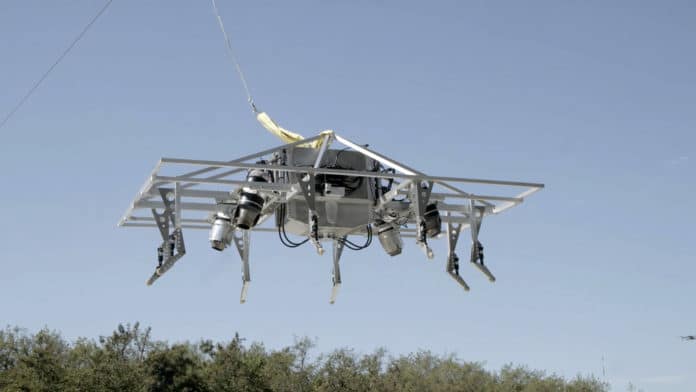More than one and half years ago, David Mayman, inventor, madman, and one of the world’s very few expert jetpack pilots, announced the launch of a luxury vehicle billed as a ‘flying motorcycle.’ Since then, the engineering team has been exploring different thrust configurations, flight control, and self-stabilization software options.
And now, his California-based company, JetPack Aviation, has completed flight testing of its first prototype and is ready to take preorders. The company envisions the Speeder – a very small VTOL aircraft powered by extremely powerful miniature jet turbines – as both a pleasure craft and a mission vehicle well-suited for the emergency medical services (EMS) and fire and rescue operations.
The company’s P1 prototype has an aluminum frame and was tethered during recent flight tests in Southern California, reaching several standards that demonstrated the Speeder’s ability to take off, climb, hover, and yaw and perform slow transitions in a forward flight. The engine gimbal and articulated exhaust nozzle systems, combined with the mechanical elements of the Speeder control system, operate in conjunction with the flight controller, comprising a computer and flight sensors, to enable the aircraft’s maneuverability.
The Speeder can reach altitudes of 15,000 feet, have a flight time of up to 30 minutes, and will eventually be capable of producing a maximum thrust of 1,200 lbs. With the payload on board, the automated flying motorcycle can reach a maximum speed of 300 mph (480 km/h), though a manned version would be slower so the pilot could safely see and breathe.
Small enough to be transported in a trailer, the Speeder runs on diesel or kerosene and doesn’t need charging before taking off. And unlike a jetpack, there isn’t much prep work required to launch – you’d just hop on and fly.
Jetpack Aviation is already working on the next iteration, the P1.5, which will use a smaller chassis with carbon fiber body panels. It will look closer to the final production model and will fly without a tether. The next prototype, the P2, will have a fully formed body, small, field-removable wings, and forward canards. While the Speeder prototypes use four engines, the final production model will include up to eight engines.
Currently, the jet turbine-powered flying motorcycle burns regular Jet A-1, kerosene, or diesel, but in a recent cooperative supply agreement with Prometheus Fuels, JetPack Aviation committed to using 100% zero net carbon fuel in all its future operations.
While the Speeder will be available for commercial sale, CEO David Mayman sees it as a great potential with the military, medical teams, and fire and rescue operations. It will also be electronically self-stabilized with servo-controlled nozzles that can quickly vector the thrust from each jet in 360 degrees to make lightning-quick balance corrections and execute maneuvers.
JetPack Aviation has received backing from venture capitalist Tim Draper, an early investor in Elon Musk‘s Tesla and SpaceX. According to David Maiman, CEO of Jetpack Aviation, it was initially reported that Speeder cost $380,000, but it is likely to increase.
